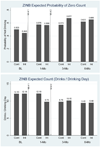A brief alcohol intervention for hazardously drinking incarcerated women
- PMID: 20402990
- PMCID: PMC2858363
- DOI: 10.1111/j.1360-0443.2009.02813.x
A brief alcohol intervention for hazardously drinking incarcerated women
Abstract
Objective: To test the hypothesis that among hazardously drinking incarcerated women who are returning to the community, a brief alcohol intervention will result in less alcohol use at follow-up relative to standard of care.
Methods: Eligible participants endorsed hazardous alcohol consumption-four or more drinks at a time on at least 3 separate days in the previous 3 months or a score of 8 or above on the Alcohol Use Disorders Identification Test. Participants were randomized to either an assessment-only condition or to two brief motivationally focused sessions, the first delivered during incarceration, the second 1 month later after community re-entry. Participants recalled drinking behaviors at 3 and 6 months after the baseline interview using a 90-day time-line follow-back method.
Results: The 245 female participants averaged 34 years of age, and were 71% Caucasian. The mean percentage of alcohol use days in the 3 months prior to incarceration was 51.7% and heavy alcohol use days was 43.9%. Intervention effects on abstinent days were statistically significant at 3 months (odds ratio = 1.96, 95% confidence interval 1.17, 3.30); the percentage of days abstinent was 68% for those randomized to intervention and 57% for controls. At 6 months the effect of the intervention was attenuated and no longer statistically significant.
Conclusions: Among incarcerated women who reported hazardous drinking, a two-session brief alcohol intervention increased abstinent days at 3 months, but this effect decayed by 6 months. Study participants continued to drink heavily after return to the community. More intensive intervention pre-release and after re-entry may benefit hazardously drinking incarcerated women.
Trial registration: ClinicalTrials.gov NCT00237003.
Keywords: Alcohol; Incarceration; Women.
Figures


References
-
- Harrison PM, Beck AJ. Prison and jail inmates at midyear 2004. U.S. Department of Justice; 2005. (Bureau of Justice Statistics, NCJ 208801)
-
- Henderson DJ. Drug abuse and incarcerated women—a research review. J Subst Abuse Treat. 1998;15:579–587. - PubMed
Publication types
MeSH terms
Associated data
Grants and funding
LinkOut - more resources
Full Text Sources
Medical

